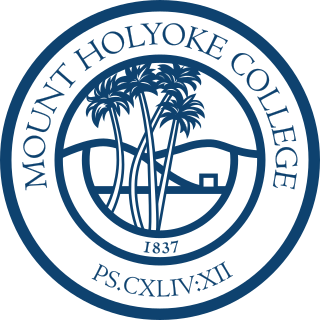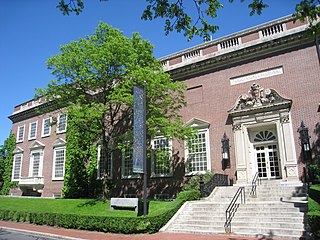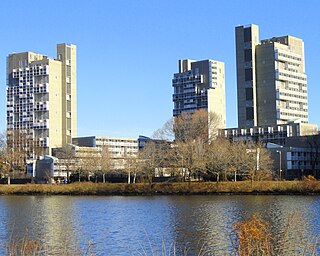
Mount Holyoke College is a private liberal arts women's college in South Hadley, Massachusetts, United States. It is the oldest member of the historic Seven Sisters colleges, a group of historically female colleges in the Northeastern United States. The college was founded in 1837 as the Mount Holyoke Female Seminary by Mary Lyon, a pioneer in education for women. Mount Holyoke is part of the Five College Consortium in Western Massachusetts.

Mark Rothko, Markus Yakovlevich Rothkowitz until 1940; September 25, 1903 – February 25, 1970), was an American abstract painter. He is best known for his color field paintings that depicted irregular and painterly rectangular regions of color, which he produced from 1949 to 1970. Although Rothko did not personally subscribe to any one school, he is associated with the American abstract expressionism movement of modern art.

Harvard College is the undergraduate college of Harvard University, a private Ivy League research university in Cambridge, Massachusetts, United States. Part of the Faculty of Arts and Sciences, Harvard College is Harvard University's traditional undergraduate program, offering AB and SB degrees. It is highly selective, with fewer than four percent of applicants being offered admission as of 2022.

The Harvard Crimson is the student newspaper of Harvard University and was founded in 1873. Run entirely by Harvard College undergraduates, it served for many years as the only daily newspaper in Cambridge, Massachusetts.

The Carpenter Center for the Visual Arts at Harvard University, in Cambridge, Massachusetts is the only building designed primarily by Le Corbusier in the United States—he contributed to the design of the United Nations Secretariat Building—and one of only two in the Americas. Le Corbusier designed it with the collaboration of Chilean architect Guillermo Jullian de la Fuente at his 35 rue de Sèvres studio; the on-site preparation of the construction plans was handled by the office of Josep Lluís Sert, then dean of the Harvard Graduate School of Design. He had formerly worked in Le Corbusier's atelier and had been instrumental in winning him the commission. The building was completed in 1962.

Josep Lluís Sert i López was a Spanish architect and city planner established in the USA after 1939.

The Rothko Chapel is a non-denominational chapel in Houston, Texas, founded by John and Dominique de Menil. The interior serves not only as a chapel, but also as a major work of modern art: on its walls are fourteen paintings by Mark Rothko in varying hues of black. The shape of the building—an octagon inscribed in a Greek cross—and the design of the chapel were largely influenced by the artist. The chapel sits two miles southwest of downtown in the Montrose neighborhood, situated between the building housing the Menil Collection and the Chapel of Saint Basil on the campus of the University of Saint Thomas. About 110,000 people visit the chapel each year.

The W. E. B. Du Bois Library is one of the three libraries of the University of Massachusetts Amherst, Amherst, Massachusetts, the others being the Science and Engineering Library and the Wadsworth Library at the Mount Ida Campus. The W. E. B. Du Bois Library holds resources primarily in humanities and social and behavioral sciences. At 28 stories and 286 feet 4+1⁄8 inches tall, it is the third-tallest library in the world after the National Library of Indonesia in Jakarta at 414 feet and Shanghai Library in China at 348 feet. Measuring taller purely by height, the libraries in Jakarta and Shanghai both only have 24 floors. The W. E. B. Du Bois Library is also considered to be the tallest academic research library and 32nd tallest educational building in the world. The building maintains a security force, which is managed by various supervisors and student employees.

The Harvard Lampoon is an undergraduate humor publication founded in 1876 by seven undergraduates at Harvard University in Cambridge, Massachusetts.

Harvard Stadium is a U-shaped college football stadium in the northeast United States, located in the Allston neighborhood of Boston, Massachusetts. The stadium is owned and operated by Harvard University and is home to the Harvard Crimson football program. In its current form, Harvard Stadium seats just over 25,000 spectators.

The Harvard University Science Center is Harvard University's main classroom and laboratory building for undergraduate science and mathematics, in addition to housing numerous other facilities and services. Located just north of Harvard Yard, the Science Center was built in 1972 and opened in 1973 after a design by Josep Lluís Sert, who was then dean of the Harvard Graduate School of Design.

Mather House is one of twelve undergraduate residential Houses at Harvard University. Opened in 1970, it is named after Increase Mather, a Puritan in the Massachusetts Bay Colony who served as President of Harvard University from 1681 to 1701. Mather's Faculty Deans are Lakshminarayanan Mahadevan and Amala Mahadevan.

The Ray Lavietes Basketball Pavilion at the Briggs Athletic Center is a 1,636-seat multi-purpose arena in the Allston neighborhood of Boston. Owned by Harvard University, it is the second-oldest college basketball arena still in use.

The Harvard Art Museums are part of Harvard University and comprise three museums: the Fogg Museum, the Busch-Reisinger Museum, and the Arthur M. Sackler Museum, and four research centers: the Archaeological Exploration of Sardis, the Center for the Technical Study of Modern Art, the Harvard Art Museums Archives, and the Straus Center for Conservation and Technical Studies. The three museums that constitute the Harvard Art Museums were initially integrated into a single institution under the name Harvard University Art Museums in 1983. The word "University" was dropped from the institutional name in 2008.

The Intermuseum Conservation Association is the oldest non-profit art conservation center in the United States, currently located in Cleveland, OH. The ICA offers conservation and preservation treatments for paintings, murals, works on paper, documents, objects of all media, outdoor sculpture, monuments, and textiles.

The John W. Weeks Memorial Bridge, usually called the Weeks Footbridge or simply Weeks Bridge, is a pedestrian bridge over the Charles River, located four miles northwest of downtown Boston on the Harvard University campus. The bridge connects Harvard’s original Cambridge campus with the Harvard Business School and many of the school’s athletic facilities in Allston.

Peabody Terrace, on the north bank of the Charles River in Cambridge, Massachusetts, is a Harvard University housing complex primarily serving graduate students, particularly married students and their families. Designed in the brutalist style and constructed in 1964, its three-story perimeter grows to five and seven stories within, with three interior 22-story towers.
Edward Waldo Forbes (1873-1969) was an American art historian. He was the Director of the Fogg Art Museum at Harvard University from 1909 to 1944.

Alfred D. Crimi, also known as Alfredo Crimi,, was an Italian-American painter.



















